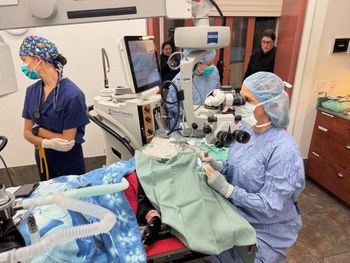
6 eye errors youre probably overlooking
Do you hesitate to prescribe antivirals? Or fail to check both eyes? Make sure you arent overlooking these common eye care oversights.
Eric Isselee/Shutterstock.comLet's set some guidelines. Are these the six worst mistakes I've ever seen? No. Are they the most common mistakes veterinarians make? Not necessarily. Ten different ophthalmologists would probably give you 10 different (but overlapping) lists. Instead, this list encompasses six mistakes I've regularly encountered in 33 years of referral examinations and phone consultations with other veterinarians.
1. Hesitating to administer antivirals
Conjunctivitis and corneal ulcers are often encountered in cats. Feline herpesvirus (FHV) infection is arguably the most common cause of feline conjunctivitis, and it is definitely the most common cause of feline corneal ulcers. Since most cats have been exposed to FHV at some point, a pragmatic approach is to assume that cats with these conditions have FHV infection unless proven otherwise.
Topical antiviral treatment should be started immediately for any cat with a corneal ulcer and should be considered for cats with conjunctivitis that don't respond to antibiotic treatment within a few days. Though no antiviral medications have been approved for use in cats, several are used. Idoxuridine 0.1% and cidofovir 0.5% solutions aren't commercially available but can be obtained from a compounding pharmacist, and local pharmacies should carry both trifluridine 1% solution (Viroptic-Monarch Pharmaceuticals) and famciclovir tablets (Famvir-Novartis).
I start with idoxuridine drops on the affected eye or eyes four times a day as it is the least expensive and is usually well-tolerated and effective. There is evidence that using cidofovir twice a day is as effective as using idoxuridine four times a day, but it is more expensive. Oral famciclovir is safe at doses up to 40 mg/kg three times a day. However, rather than dosing on a mg/kg basis, many ophthalmologists simply administer 62.5 mg or 125 mg twice a day. The tablets are available in 125-mg and 250-mg sizes. You can combine topical and oral treatments in refractory cases.
2. Examining only one eye
When consulting with a veterinarian over the phone, if I'm only given information about one eye, I usually ask about the other. Often I'm told, “That eye is normal, so I didn't examine it.” Wrong! Both eyes need to be examined so we know what's normal for that patient.
It's important to note that an eye can appear normal and still have occult disease. For example, I once performed an eye screening on a show dog with no obvious visual deficits, yet one eye had a complete retinal detachment.
3. Relying too much on normal IOP ranges
The often cited normal range of intraocular pressure (IOP) for dogs and cats is 10 to 25 mm Hg. However, the normal IOP range will vary according to the instrument and technique used, the examiner, the degree of restraint, any surface disease, and the time of day.
In my experience, for example, a normal IOP range is usually 8 to 20 mm Hg when using an applanation or rebound tonometer. I seldom obtain readings higher than 20 mm Hg in normal eyes, and I examine multiple patients daily with noninflamed eyes that have IOPs below 10 mm Hg. Most of these patients with IOPs just below 10 mm Hg do not have uveitis.
What is sometimes more important than the absolute IOP determination is the difference between the two eyes when correlated with clinical signs. Let's say that Dog A has an inflamed right eye (OD) and a noninflamed left eye (OS). The IOPs are 13 mm Hg OD and 19 mm Hg OS. In this example, the inflamed eye has a lower IOP than the normal eye, and that alone supports a diagnosis of uveitis. Under normal circumstances, the IOP of each eye should not differ by more than 2 or 3 mm Hg.
Dog B presents for its annual examination. The owner has no concerns, and both eyes are visual and noninflamed. You check the dog's IOPs and obtain readings of 30 mm Hg for both eyes. You should certainly pause to consider whether this dog has glaucoma, but given its history and presentation, it is more likely that the IOPs are artificially elevated from errors in technique or restraint. You might refer this patient for a second opinion but start a hypotensive drop pending referral.
And finally, what about Dog C, a cocker spaniel that presents with a noninflamed right eye and an inflamed left eye? The IOPs are 10 mm Hg OD and 19 mm Hg OS. In this instance, the red eye has an IOP that is within the normal range, but because the cocker spaniel is a high-risk breed for glaucoma and the inflamed eye has a higher IOP than the noninflamed eye, this dog may be on the verge of glaucoma.
4. Not checking tear production
One of the most common canine eye diseases is keratoconjunctivitis sicca (KCS), or dry eye. The signs can vary, but KCS can literally be diagnosed in one minute-two minutes if you test each eye separately. However, when confronted with an irritated eye, many veterinarians forget to check tear production.
A Schirmer tear test (STT) can confirm a KCS diagnosis. An STT-1 is performed before applying diagnostic reagents to the eye. It measures both reflex and basal tear production and should be performed on any patient with an irritated eye, ocular discharge or corneal disease of undetermined cause. (An STT-2 is performed after a topical anesthetic has been applied to the eye and, thus, primarily measures basal tear production.)
A normal STT-1 value is > 15 mm of wetting after one minute for both dogs and cats. A lower STT-1 value in a dog is consistent with KCS when correlated with clinical signs. Cats are different. Low STT-1 values are common in cats with noninflamed and otherwise normal eyes, though the published normal values are similar to that of dogs. Thus, the difference in STT-1 values between the eyes may be more important for interpretation in cats than the absolute value.
5. Waiting too long to reexamine eyes
Eye disease can progress quickly. With some eye diseases (e.g. deep or infected corneal ulcers), reexamination in 24 to 48 hours is appropriate. If in doubt, err on the side of seeing the patient sooner rather than later.
Consider a dog in with an IOP of 54 mm Hg in which you correctly diagnose glaucoma. You administer appropriate hypotensive treatments to reduce the IOP, and you tell the owner to bring the dog back in a month. When the dog returns, the affected eye is blind. What happened? The glycerin or mannitol you administered for rapid reduction in pressure was out of the dog's system in 12 to 24 hours, and the drops dispensed were insufficient to control the pressure.
Or consider a dog (e.g. a basset hound) with an eye that appears to have a simple conjunctivitis or mild uveitis. You correctly start corticosteroids, and the dog comes back a few days later with glaucoma. This dog is a high-risk breed for glaucoma, and if the pressure was high normal at the initial examination, the eye was probably already on the verge of glaucoma. Remember that with uveitis, IOP tends to be low, so when the uveitis is treated, the pressure can rebound above normal limits.
6. Stopping treatment too soon
Many eye diseases require long-term or lifetime treatment. Well-intended veterinarians often make the correct diagnosis and start appropriate treatment but then stop treatment once the eye improves. Yes, cyclosporine or tacrolimus may have improved tear production, but tear production will probably decline again if the treatment is discontinued. Even for patients with KCS, in which tear production never improves, these drugs can slow the progression of corneal disease, improve comfort and prolong vision.
With some conditions (e.g. patients with early cataracts susceptible to lens-induced uveitis or a golden retriever in which early pigmentary uveitis is suspected), I may instruct an owner to continue a treatment twice weekly. This low frequency is unlikely to have any adverse effects and can be beneficial. If nothing else, it makes the owner look at the patient's eyes at least twice a week.
My hope is that by calling attention to these errors, you will pause the next time you have a patient with an eye problem and ask, “Am I making one of those common mistakes that ophthalmologist wrote about?” and then proceed to provide the best care possible.
Dr. Collins is a practicing veterinarian at Eye Care for Animals in Pewaukee, Wisconsin.
Newsletter
From exam room tips to practice management insights, get trusted veterinary news delivered straight to your inbox—subscribe to dvm360.




